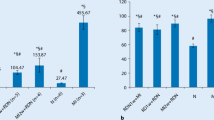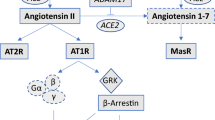Abstract
Purpose
Long-term monotherapy with the aldosterone receptor blocker eplerenone in dogs with HF was previously shown to improve LV systolic and diastolic function. This study examined the effects of long-term monotherapy with the aldosterone receptor blocker eplerenone on mRNA and protein expression of the cytoskeletal proteins titin, tubulin, fibronectin and vimentin, the matrix metalloproteinases (MMPs)-1, -2 and -9, and the tissue inhibitors of MMPs (TIMPs)-1 and -2 in left ventricular (LV) myocardium of dogs with heart failure (HF).
Methods
HF was produced in 12 dogs by intracoronary microembolizations. Dogs were randomized to 3 months oral therapy with eplerenone (10 mg/kg twice daily, n = 6) or to no therapy at all (HF-control, n = 6). LV tissue from six normal dogs was used for comparison. mRNA expression was measured using reverse-transcriptase polymerase chain reaction (RT-PCR) and protein expression using Western blots.
Results
Compared to NL dogs, control dogs showed upregulation of mRNA and protein expression for tubulin, fibronectin, MMP-1, -2 and -9, and down-regulation of mRNA and protein expression for total titin. Normalization of mRNA and protein expression for all these genes was seen after treatment with eplerenone. N2BA/N2B-titin mRNA expression ratio increased significantly in dogs with HF treated with eplerenone. No differences in expression for vimentin, TIMP-1 and -2 were observed among groups.
Conclusions
In dogs with HF, long-term eplerenone therapy normalizes mRNA and protein expression of key cytoskeletal proteins and MMPs. Reversal of these molecular maladaptations may partly explain the improvement in LV diastolic function seen after long-term therapy with eplerenone.





Similar content being viewed by others
References
Weber KT, Brilla CG. Pathological hypertrophy and cardiac interstitium: fibrosis and renin-angiotensin-adosterone system. Circulation.. 1991;83:1849–65.
Wilke A, Funck R, Rupp H. Effects of the renin-angiotensin-aldosterone system on the cardiac interstitium in heart failure. Basic Res Cardiol.. 1996;91:79–84.
Dieterich HA, Wendt C, Saborowski F. Cardioprotection by aldosterone receptor antagonism in heart failure. Part I. The role of aldosterone in heart failure. Fiziol Cheloveka.. 2005;31:97–105.
Wu Y, Bell SP, Trombitas K, et al. Changes in titin isoform expression in pacing-induced cardiac failure give rise to increased passive muscle stiffness. Circulation.. 2002;106:1384–9.
Suzuki G, Morita H, Mishima T, et al. Effects of long-term monotherapy with eplerenone, a novel aldosterone blocker, on progression of left ventricular dysfunction and remodeling in dogs with heart failure. Circulation.. 2002;106:2967–72.
Sabbah HN, Sharov VG, Lesch M, Goldstein S. Progression of heart failure: a role for interstitial fibrosis. Mol Cell Biochem.. 1995;147:29–34.
Morita H, Khanal S, Rastogi S, et al. Selective matrix metalloproteinase inhibition attenuates progression of left ventricular dysfunction and remodeling in dogs with chronic heart failure. Am J Physiol.. 2006;290:H25–7.
Funck RC, Wilke A, Rupp H, Brilla CG. Regulation and role of myocardial collagen matrix remodeling in hypertensive heart disease. Adv Exp Med Biol.. 1997;432:35–44. Review.
Pitt B, Zannad F, Remme WJ, Cody R, Castaigne A, Perez A, et al. The effect of spironolactone on morbidity and mortality in patients with severe heart failure. Randomized Aldactone Evaluation Study Investigators. N Engl J Med.. 1999;341:709–17. Sep 2.
Pitt B, Williams G, Remme W, Martinez F, Lopez-Sendon J, Zannad F, et al. The EPHESUS trial: eplerenone in patients with heart failure due to systolic dysfunction complicating acute myocardial infarction. Eplerenone Post-AMI Heart Failure Efficacy and Survival Study. Cardiovasc Drugs Ther.. 2001;15:79–87.
Pitt B, Remme W, Zannad F, Neaton J, Martinez F, Roniker B, et al. Eplerenone Post-acute Myocardial Infarction Heart Failure Efficacy and Survival Study Investigators. Eplerenone, a selective aldosterone blocker, in patients with left ventricular dysfunction after myocardial infarction. N Engl J Med.. 2003;348:1309–21.
Sabbah HN, Stein PD, Kono T, et al. A canine model of chronic heart failure produced by multiple sequential coronary microembolizations. Am J Physiol.. 1991;260:H1379–84.
Sabbah HN, Shimoyama H, Kono T, et al. Effects of long-term monotherapy with enalapril, metoprolol, and digoxin on the progression of left ventricular dysfunction and dilation in dogs with reduced ejection fraction. Circulation.. 1994;89:2852–9.
Spencer WE, Christensen MJ. Multiplex relative RT-PCR method for verification of differential gene expression. Biotechniques. 1999;27:1044–6, 1048–50, 1052.
Feldman AM, Ray PE, Silan CM, Mercer JA, Minobe W, Bristow MR. Selective gene expression in failing human heart. Quantification of steady-state levels of messenger RNA in endomyocardial biopsies using the polymerase chain reaction. Circulation. 1991;83:1866–72.
Chomczynski P, Sacchi N. The single-step method of RNA isolation by acid guanidinium thiocyanate-phenol-chloroform extraction: twenty-something years on. Nat Protoc.. 2006;1:581–5.
Gupta RC, Mishra S, Mishima T, et al. Reduced sarcoplasmic reticulum Ca(2+)-uptake and expression of phospholamban in left ventricular myocardium of dogs with heart failure. J Mol Cell Cardiol.. 1999;7:1381–9.
Mishra S, Gupta RC, Tiwari N, et al. Molecular mechanisms of reduced sarcoplasmic reticulum Ca(2+) uptake in human failing left ventricular myocardium. J Heart Lung Transplant.. 2002;21:366–73.
Lowry OH, Rosebrough NJ, Farr AL, et al. Cleavage of structural proteins during the assembly of the head of bacteriophage T4. Nature.. 1951;227:680–85.
Barnes BJ, Howard PA. Eplerenone: a selective aldosterone receptor antagonist for patients with heart failure. Ann Pharmacother.. 2005 Jan;39:68–76.
Staessen J, Lijnen P, Fagard R, Verschueren LJ, Amery A. Rise in plasma concentration of aldosterone during long-term angiotensin II suppression. J Endocrinol. 1981;91:457–65.
McKelvie RS, Yusuf S, Pericak D, Avezum A, Burns RJ, Probstfield J, et al. Comparison of candesartan, enalapril, and their combination in congestive heart failure: Randomized Evaluation of Strategies for Left Ventricular Dysfunction (RESOLVD) pilot study. The RESOLVD Pilot Study Investigators. Circulation. 1999;100:1056–64.
Brown NJ. Eplerenone: cardiovascular protection. Circulation.. 2003;107:2512–8. Review.
Keller TCS. Structure and function of titin and nebulin. Curr Opin Cell Biol.. 1995;7:32–8.
Granzier H, Wu Y, Siegfried L, et al. Titin: physiological function and role in cardiomyopathy and failure. Heart Fail Rev.. 2005;10:211–23.
Wu Y, Cazorla O, Labeit D, Labeit S, Granzier H. Changes in titin and collagen underlie diastolic stiffness diversity of cardiac muscle. J Mol Cell Cardiol.. 2000;32:2151–62.
Neagoe C, Kulke M, del Monte F, et al. Titin isoform switch in ischemic human heart disease. Circulation.. 2002;106:1333–41.
Wu Y, Bell SP, Trombitas K, et al. Changes in titin isoform expression in pacing-induced cardiac failure give rise to increased passive muscle stiffness. Circulation.. 2002;106:1384–89.
Cazorla O, Freiburg A, Helmes M, Centner T, McNabb M, Wu Y. Differential expression of cardiac titin isoforms and modulation of cellular stiffness. Circ Res.. 2000;86:59–67.
Miller KM, Granzier H, Ehler E, Gregorio CC. The sensitive giant: the role of titin-based stretch sensing complexes in the heart. Trends Cell Biol.. 2004;14:119–26.
Warren CM, Jordan MC, Roos KP, Krzesinski PR, Greaser ML. Titin isoform expression in normal and hypertensive myocardium. Cardiovasc Res.. 2003;59:86–94.
Aquila-Pastir LA, Dipaola NR, Matteo RG, Smedira NG, McCarthy PM, Moravec CS. Quantification and distribution of beta-tubulin in human cardiac myocytes. J Mol Cell Cardiol.. 2002;34:1513–23.
Sharov VG, Kostin S, Todor A, Schaper J, Sabbah HN. Expression of cytoskeletal, linkage and extracellular proteins in failing dog myocardium. Heart Fail Rev.. 2005;10:297–303.
Hynes RO. Fibronectins. Berlin, Germany: Springer; 1989.
Heling A, Zimmermann R, Kostin S, et al. Increased expression of cytoskeletal, linkage, and extracellular proteins in failing human myocardium. Circ Res.. 2000;86:846–53.
Kossmehl P, Schonberger J, Shakibaei M, et al. Increase of fibronectin and osteopontin in porcine hearts following ischemia reperfusion. J Mol Med.. 2005;83:626–37.
Rastogi S, Mishra S, Gupta RC, Sabbah HN. Reversal of maladaptive gene program in left ventricular myocardium of dogs with heart failure following long-term therapy with the acorn cardiac support device. Heart Fail Rev.. 2005;10:157–63.
Tsutsui H, Ishihara K, Cooper G. Cytoskeletal role for contractile dysfunction of hypertrophied myocardium. Science.. 1993;260:682–7.
Tsutsui H, Tagawa H, Kent RL, et al. Role of microtubules in contractile dysfunction of hypertrophied cardiocytes. Circulation.. 1994;90:533–55.
Tagawa H, Koide M, Sato I, Cooper G. Cytoskeletal role in the contractile dysfunction of cardiomyocytes from hypertrophied and failing right ventricular myocardium. Proc Assoc Am Physicians.. 1996;108:218–29.
Tagawa H, Rozich JD, Tsutsui H, et al. Basis of increased microtubules in pressure hypertrophied cardiocytes. Circulation.. 1996;93:1230–43.
Tagawa H, Wang N, Narishige T, Ingber DE, Zile MR, Cooper G. Cytoskeletal mechanics in pressure-overload cardiac hypertrophy. Circ Res.. 1997;80:281–9.
Hein S, Kostin S, Heling A, Maeno Y, Schaper J. The role of the cytoskeleton in heart failure. Cardiovasc Res.. 2000;45:273–8.
Wang X, Li F, Campbell SE, Gerdes M. Chronic pressure overload hypertrophy and failure in guinea pigs. J Mol Cell Cardiol.. 1999;31:319–31.
Lemler MS, Bies RD, Frid MG, et al. Myocyte cytoskeletal disorganization and right heart failure in hypoxia-induced neonatal pulmonary hypertension. Am J Physiol.. 2000;279:H136–76.
Thomas CV, Coker MI, Zellner JL, Handy JR, Crumbley AJ, Spinale FG. Increased matrix metalloproteinase activity and selective upregulation in LV myocardium from patients with end-stage dilated cardiomyopathy. Circulation.. 1998;97:1708–15.
Rastogi S, Gupta RC, Mishra S, Morita H, Tanhehco EJ, Sabbah HN. Long-term therapy with acorn cardiac support device normalizes gene expression of growth factors and gelatinases in dogs with heart failure. J Heart Lung Transplant.. 2005;10:1619–25.
Li YY, McTiernan CF, Feldman AM. Interplay of matrix metalloproteinases, tissue inhibitors of metalloproteinases and their regulators in cardiac matrix remodeling. Cardiovasc Res.. 2000;40:214–24.
Lu L, Gunja-Smith Z, Woessner JF. Matrix metalloproteinases and collagen ultrastructure in moderate myocardial ischemia and reperfusion in vivo. Am J Physiol.. 2000;279:H601–09.
Tyagi SC, Kumar S, Cassatt S, Parker JL. Temporal expression of extracellular matrix metalloproteinases and tissue plasminogen activator in the development of collateral vessels in the canine model of coronary occlusion. Can J Physiol Pharmacol.. 1996;74:983–95.
Lindsey ML, Gannon J, Aikawa M, et al. Selective matrix metalloproteinase inhibition reduces left ventricular remodeling but does not inhibit angiogenesis after myocardial infarction. Circulation.. 2002;105:753–58.
Acknowledgments
This study was supported, in part, by grants from the National Heart, Lung, and Blood Institute PO1 HL074237-04.
Author information
Authors and Affiliations
Corresponding author
Rights and permissions
About this article
Cite this article
Rastogi, S., Mishra, S., Zacà, V. et al. Effect of Long-term Monotherapy with the Aldosterone Receptor Blocker Eplerenone on Cytoskeletal Proteins and Matrix Metalloproteinases in Dogs with Heart Failure. Cardiovasc Drugs Ther 21, 415–422 (2007). https://doi.org/10.1007/s10557-007-6057-8
Published:
Issue Date:
DOI: https://doi.org/10.1007/s10557-007-6057-8




